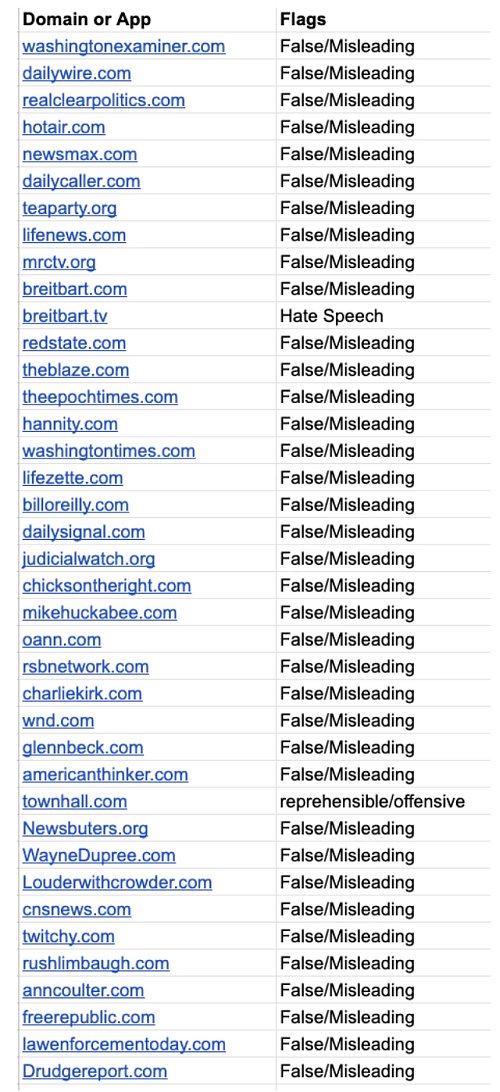A real blacklist designed to choke ad profits from conservative and legitimate news organizations

Conservative news outlets blacklisted by Microsoft’s Xandr,
based on advice from GDI
They’re coming for you next: Using American federal funds, a British “disinformation” group called the Global Disinformation Index (GDI) has created a real blacklist of valid and longstanding conservative news organizations and fed that list to internet ad companies to encourage them to cut ad revenue from those news organizations.
A sampling of the blacklisted news companies that have actually been punished financially by this effort is shown to the right
Of the ad companies, a Microsoft company named Xander appears to be the most enthusiastic about using GDI’s blacklist to choke ad sales to conservatives sites.
GDI’s “dynamic exclusion list” includes at least 2,000 domains, many of which are “foreign state-sponsored news and opinion sites, forums that traffic in disinformation, and explicitly sanctioned websites,” according to a second source close to Microsoft. Each month, GDI sends Xandr a list of websites on this blacklist, said the source.
The Washington Examiner revealed on Thursday that it is on GDI’s list and spoke to an ad-buying source who said Breitbart News is also. Separately, GDI has said that the 10 “riskiest” news outlets for purported disinformation are the American Spectator, Newsmax, the Federalist, the American Conservative, One America News Network, the Blaze, the Daily Wire, RealClearPolitics, Reason, and the New York Post.
All those news outlets are legitimate, well established, and reasonable and reliable sources of information. No one should rely solely on them for their news, but to call their reporting “false,” “misleading,” “hate speech,” “reprehensible,” or “offensive” merely because they publish news from a conservative perspective is fundamentally dishonest. To then blacklist them because they have a different perspective is pure censorship by the left against its political opponents.
That the blacklist is definitely partisan is proven by the news outlets GDI has determined are acceptable.
» Read more

Conservative news outlets blacklisted by Microsoft’s Xandr,
based on advice from GDI
They’re coming for you next: Using American federal funds, a British “disinformation” group called the Global Disinformation Index (GDI) has created a real blacklist of valid and longstanding conservative news organizations and fed that list to internet ad companies to encourage them to cut ad revenue from those news organizations.
A sampling of the blacklisted news companies that have actually been punished financially by this effort is shown to the right
Of the ad companies, a Microsoft company named Xander appears to be the most enthusiastic about using GDI’s blacklist to choke ad sales to conservatives sites.
GDI’s “dynamic exclusion list” includes at least 2,000 domains, many of which are “foreign state-sponsored news and opinion sites, forums that traffic in disinformation, and explicitly sanctioned websites,” according to a second source close to Microsoft. Each month, GDI sends Xandr a list of websites on this blacklist, said the source.
The Washington Examiner revealed on Thursday that it is on GDI’s list and spoke to an ad-buying source who said Breitbart News is also. Separately, GDI has said that the 10 “riskiest” news outlets for purported disinformation are the American Spectator, Newsmax, the Federalist, the American Conservative, One America News Network, the Blaze, the Daily Wire, RealClearPolitics, Reason, and the New York Post.
All those news outlets are legitimate, well established, and reasonable and reliable sources of information. No one should rely solely on them for their news, but to call their reporting “false,” “misleading,” “hate speech,” “reprehensible,” or “offensive” merely because they publish news from a conservative perspective is fundamentally dishonest. To then blacklist them because they have a different perspective is pure censorship by the left against its political opponents.
That the blacklist is definitely partisan is proven by the news outlets GDI has determined are acceptable.
» Read more

